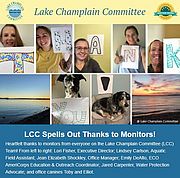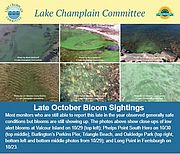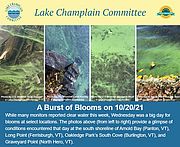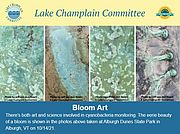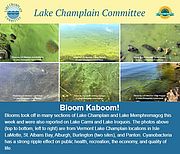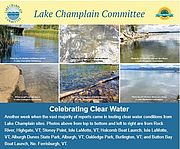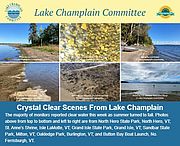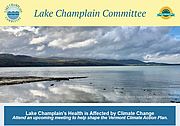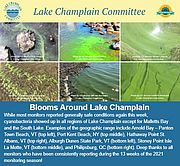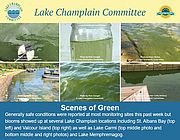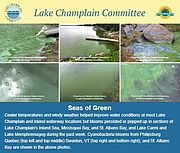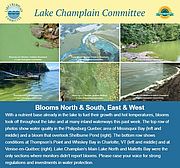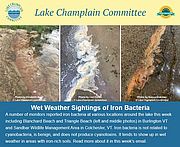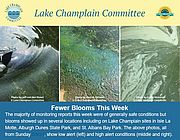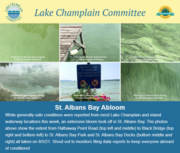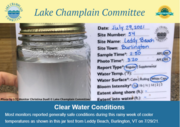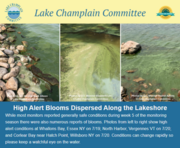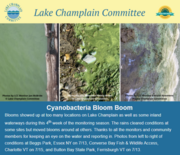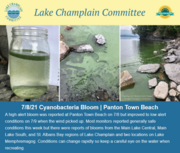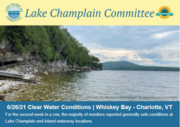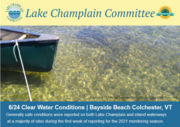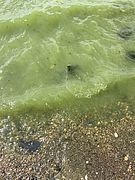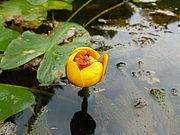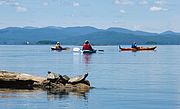The Lake Champlain Committee (LCC), Conservation Law Foundation (CLF), and Vermont Natural Resources Council (VNRC), have jointly filed a petition requesting that the Environmental Protection Agency (EPA) either force the State to correct its failed administration of the Clean Water Act or step in to regulate clean water enforcement in Vermont itself. Right now, the state’s Agency of Natural Resources and Agency of Agriculture both oversee clean water regulation on farms, a situation which leads to confusion and mistrust among farmers. Read...
News from Selected Month
Vermont is becoming warmer and wetter due to climate change. Specifically, the Vermont Climate Assessment 2021 notes that both summer and spring precipitation have increased in the Green Mountain State. The Assessment cautions that “[t]his spring precipitation . . . can make farm operations difficult.” Read...
In sun and rain, heat and cold, monitors collectively filed over 2,700 reports during the 2021 season. Read...
Most monitors reported generally safe conditions during this 19th week of the monitoring season but blooms were also witnessed at select locations. Read...
Wetlands are vital natural resources that must be protected and restored for Vermont to address the impacts of climate change, protect wildlife habitat, restore, and maintain the quality of our waters, and provide other benefits for people and nature. In light of their significance, we believe the state of Vermont must commit to a “net gain” of wetlands. Read...
While color is fading on the hillsides, it unfortunately is still showing up in the water. October 20 was a particularly busy day for cyanobacteria sightings with blooms reported at a scattering of locations up and down Lake Champlain. Scroll through this email to view pictures of the conditions witnessed at Arnold Bay, Burlington beaches, Island sites, St. Albans Bay, and Lake Memphremagog during this 18th week of cyanobacteria monitoring. You’ll also find some visuals and details about duckweed, water samples rimmed with cyanobacteria, and resources and links to help you recognize, avoid, and report cyanobacteria. Read...
Unfortunately, this was another big week for blooms—with reports of cyanobacteria coming in from all sections of Lake Champlain except Malletts Bay, Missisquoi Bay, and the South Lake. Blooms were also reported from Clyde Pond, Lake Carmi, Lake Iroquois, Lake Memphremagog, and Shelburne Pond. We have fewer monitors watching the water at this time of year but blooms can still show up as evidenced by the reports and photos compiled from this week. Please use the resources and links in this email to learn how to recognize, avoid, and report cyanobacteria. Read...
Unfortunately, this was a big week for blooms—reports of cyanobacteria were chronicled at all Lake Champlain sections except the South Lake and Malletts Bay. Blooms expanded in many areas of Lake Memphremagog and were reported on Lake Carmi and Lake Iroquois. You can get a sense of the impact of a bloom by watching this video taken on 10/6/21 by Missisquoi National Wildlife Refuge Manager Ken Sturm. Ken and his team witnessed an extensive swath of dense cyanobacteria in Missisquoi Bay during a 20-minute boat ride from the east delta all the way around to Long Marsh Bay. Read...
Monday, October 4th 2021
To the Vermont Climate Council,
...Significant parts of the world are literally on fire, and big portions of the rest of the nation are (or were recently) underwater. Vermont itself has recently missed being hit by not one but two massive tropical storms by mere miles, and earlier forecasts for the path of both Henri and Ida warned they might go directly through our state. And, of course, Vermonters are already experiencing more extreme heat and heavy precipitation events climate scientists have predicted for years. Read...
Clear water dominated on the cyanobacteria tracker during this first full week of fall and the 15th week of the cyanobacteria monitoring program. Most monitors who are still able to report recorded safe conditions, great for late-season recreation. Cyanobacteria was reported at one site each in Lake Champlain’s Main Lake Central and Main Lake South sections and several times during the week at Lake Carmi. Read...
Fewer reports are flowing in as we move into fall, park staff leave posts, and seasonal residents close up camps. However, late season blooms are not uncommon so please keep checking conditions whenever you recreate in or around water. Read...
The state of Vermont is developing its Climate Action Plan and drafters need your input to produce a forward-thinking guidance document that addresses the climate emergency. Seven events to gain public comments will be held throughout the state beginning tomorrow and running through early October. Read...
Although generally safe conditions dominated the cyanobacteria tracker again this week, we received reports of cyanobacteria from all Lake Champlain regions except the South Lake and Malletts Bay. Monitors also logged in bloom reports for some sites on Lake Carmi and Lake Memphremagog. Read...
Generally safe conditions prevailed at most locations again this week but cyanobacteria was reported at Lake Champlain’s Main Lake Central, Main Lake South, Missisquoi Bay, St. Albans Bay, and South Lake and at Lake Carmi and Lake Memphremagog. Read...
Windy, cooler weather helped improve water quality conditions during this eleventh week of monitoring. While generally safe conditions prevailed at most locations, cyanobacteria was reported at Lake Champlain’s Inland Sea, Missisquoi Bay, and St. Albans Bay as well as Lake Carmi and Lake Memphremagog. Read...
Cyanobacteria Monitors filed over 240 reports this past week as blooms popped up or persisted in numerous locations on Lake Champlain and several inland waterbodies. Lake Champlain’s Inland Sea, Main Lake Central, Main Lake South, Missisquoi Bay, South Lake, and St. Albans Bay all experienced blooms as did Chittenden Reservoir, Lake Carmi, Lake Iroquois, Lake Memphremagog, and Shelburne Pond. Read...
Happy Friday! Lots of green dots populated the cyanobacteria tracker this week and reports of clear water, non-filamentous green algae, and iron bacteria dominated over cyanobacteria in most areas. However, we did have cyanobacteria bloom reports from Lake Carmi and Lake Morey as well as Lake Champlain’s Inland Sea and low and high alert conditions at several St. Albans Bay sites as of today (8/20/21). Read...
Cyanobacteria monitors kept us busy again this week with 136 Lake Champlain reports and 43 from inland waterways. Blooms occurred in the Lake Champlain’s Inland Sea, Main Lake North, Malletts Bay, and St. Albans Bay as well as Indian Brook Reservoir and Lake Carmi as of this writing. Read...
We had many clear water reports early in the week but conditions changed in some areas as the temperatures rose and the air stilled later in the week. A bloom took off in St. Albans Bay, and alert conditions were witnessed elsewhere on Lake Champlain, Lake Carmi, and Lake Memphremagog. Read...
Happily water conditions improved significantly this week! Roughly 85% of the Lake Champlain reports and 94% of inland waterway reports showed generally safe conditions. Read...
Another busy week of monitoring with variable conditions up and down Lake Champlain. While most monitors reported generally safe conditions at Lake Champlain and inland waterway monitoring sites, low and high alert blooms were in evidence too. Lake Champlain’s St. Albans Bay, Inland Sea, Malletts Bay, Main Lake North, Main Lake Central, and Main Lake South, along with Indian Brook Reservoir and Lake Carmi, all experienced cyanobacteria blooms. Read...
Lake Champlain Committee (LCC) and community monitors filed a total of 246 reports this week as blooms showed up in a host of Lake Champlain shoreline and inland lake locations. Escalating temperatures spurred cyanobacteria growth that closed beaches at several lakeshore communities. Read...
Although generally safe conditions still dominate on the cyanobacteria datatracker, blooms showed up in several sections of Lake Champlain and Lake Memphremagog this week. Read...
While we received some reports of low alert cyanobacteria conditions on Lake Champlain and Lake Carmi, the majority of monitors observed generally safe conditions during this second week of the 2021 monitoring season. The cyanobacteria datatracker is populated with lots of green dots again this week. Yay! Read...
Monitoring began this week and will run through early fall. This week’s report covers conditions from Sunday, June 20 through early-afternoon on Friday June 25. The vast majority of reports we’ve received to date indicate generally safe conditions. Yay! Read...
Cyanobacteria blooms: Why do they happen, what are the risks, and what can we do?
Cyanobacteria blooms have received increasing attention in recent years, as a result of
particularly strong blooms in some areas. As research into blooms continues, we learn
more about what things make cyanobacteria blooms more likely, what dangers blooms
can pose to humans and other animals, and what the future might hold.
They touch the tips of swimmers’ toes, wrap around fish hooks, anchors, and paddles, and form underwater meadows near shorelines—native aquatic plants are ubiquitous in Lake Champlain Basin waterbodies. The roles these aquatic superstars play in lake ecosystems are often undervalued. It is not uncommon to hear native aquatic plants described as “yucky weeds”—let’s dispel this viewpoint! Read...
We have good news to share! Earlier this week--in response to opposition from the Lake Champlain Committee (LCC), the Vermont Natural Resources Council (VNRC), and the public--the Lake Champlain Transportation Company and Vermont Division for Historic Preservation announced they will not sink a retired ferry in Lake Champlain. Read...
Burlington, VT -- Citing opposition from environmental groups and the public, Lake Champlain Transportation Company and Vermont Division for Historic Preservation announced today the withdrawal of its application for a permit to sink the Adirondack, a retired ferry, in Lake Champlain. Instead of being abandoned underwater to create an artificial reef for scuba divers, the vessel will be scrapped. Read...
A virtual public meeting will be help on Tuesday, May 4th from 5:30 p.m. to 7:30 p.m. to discuss the Lake Champlain Transportation Company's proposal to sink the Ferry Adirondack in Burlington Bay. Please attend the meeting and speak out about why this decision is NOT right for Vermonters or for Lake Champlain. Read...

